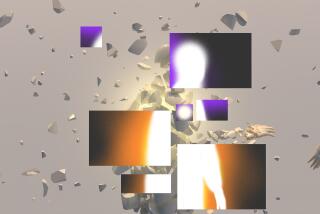BOOK REVIEW / SCIENCE : A Guided Trip Through the Human Brain : DESCARTES’ ERROR: Emotion, Reason, and the Human Brain <i> by Antonio R. Damasio</i> ; Grosset/Putnam $24.95, 313 pages
- Share via
In 1848, 25-year-old Phineas P. Gage, foreman of a crew laying track for the Rutland & Burlington Vermont railroad, turned his head for a second while preparing to set off a blast. That was a mistake. The explosive misfired, hurling Gage’s narrow 3 1/2-foot iron tamping rod into his cheek and out through the top of his head.
Had Gage died, this story would not have entered into history. But Gage, who was thrown on his back by the impact, was soon walking and talking as if little had happened, despite his gaping wound. Yet something had happened and co-workers soon observed that “Gage was no longer Gage.”
Foul language came to dominate his speech, and the attending doctor noted that the “equilibrium or balance between his intellectual faculty and animal propensities” was gone. Destitute, unable to hold jobs or friends, he joined a circus freak show for awhile and eventually moved in with his mother in San Francisco. Then he developed seizures and died in 1861.
Antonio R. Damasio, head of neurology at the University of Iowa’s medical school and an adjunct professor at the Salk Institute, introduces Gage at the book’s beginning. Thanks to the detective work of Damasio’s colleague and neurobiologist wife, Hannah, Gage’s tragedy has helped illuminate the complicated nature of human reason.
Hannah Damasio combined measurements of Gage’s skull--which had been preserved as a curiosity at the Harvard Medical School’s museum--with “Brainvox,” a magnetic resonance imaging process that constructed a 3-D image of Gage’s brain with the metal rod piercing the frontal lobes.
By knowing which part of the brain was destroyed, Antonio Damasio was able to compare Gage’s prefrontal damage and subsequent personality changes with similar results observed in his own patients, especially in a man he calls Elliot.
Once a good husband and father, Elliot complained of headaches and then seemed to lose his concentration and sense of responsibility. He took a battery of psychological tests. They showed nothing. Elliot was coherent and smart with a flawless memory of his life story. He was referred to Antonio Damasio, who found a brain tumor pressing on Elliot’s frontal lobes.
Surgery was essential and although Damasio was able to remove the tumor, Elliot’s behavior began to resemble Gage’s. Unlike Gage, however, Elliot was there for Damasio to study.
From Elliot, we learn to question our cultural admonitions to “keep a cool head” and “separate emotions from reason.” Emotion is an intrinsic part of intelligence, Elliot’s case reveals; having lost access to the part of his brain that provides emotional cues, Elliot could not make decisions.
Gage’s and Elliot’s stories lead Damasio into a remarkable discussion of the way memory and reason work. He deduces, for instance, that there is no single brain center. The summoning-up of a memory activates several brain systems working in concert on many levels. This helps confirm Damasio’s hypothesis that mind and body are connected.
“Descartes’ Error,” of course, was his separation of the mind from the body. Damasio succeeds in defending the mind-body unity in this well-written discussion. He describes what is known about the brain today, from the areas first mapped in the 19th Century to “the two principal routes of interconnection” we now understand. These are the sensory and motor nerves that carry signals from every part of the body to and from the brain, and the bloodstream that circulates chemical signals, including hormones, neurotransmitters and modulators.
Among Damasio’s more remarkable observations is that the brain always changes. Data from experience (or memory) exists in many places in the brain, and may even disappear because the brain is not a giant file cabinet. There are no hard copies of memories. Nor is it like a computer where the brain is hardware and the mind software. The brain lives in a feedback loop with the rest of the body, which makes it highly improbable that a brain could exist without a body (a favorite science-fiction theme).
Each time we recollect something, Damasio tells us, our brain collects data from different sites and pulls the information together. Always subject to editing and reconstruction, our pasts exist in a “potential state, subject to activation, like the town of Brigadoon.”
Rich in provocative concepts about intelligence, memory, creativity and even passion, “Descartes’ Error” is an excellent guide to the revelations of neurobiology.





